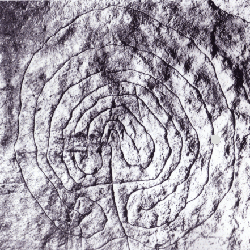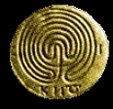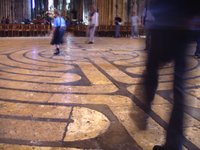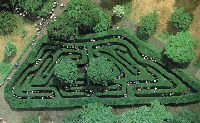maze

Labyrinth rock carving found inside a Neolithic tomb.
A maze is a network of winding and interconnected passageways that a traveler must negotiate in order to reach some goal. The terms "maze" and "labyrinth" are often used interchangeably, though sometimes a distinction is made based on the layout. A labyrinth is then defined as a construction that leads from a starting point to a goal by a single path, with no branches or dead-ends. No matter how long and twisting the route, it is predetermined by the builder: a labyrinth, according to this definition, is unicursal. A maze, by contrast, is multicursal and calls for the traveler to make a series of decisions, which affects how quickly the goal is reached. In this book, we'll use "maze" and labyrinth" to mean the same thing, and refer to unicursal and multicursal mazes.
The most famous of legendary mazes was the lair (or prison) of the Minotaur at Knossos on Crete (see Theseus and the Minotaur). According to Greek mythology, King Minos of Crete had his chief engineer, Daedalus, build the Labyrinth in order to keep the half-human half-bovine offspring of his wife Pasiphae and a bull out of the public eye. King Aegeus of Athens was forced to pay a periodic tribute to Minos (the Athenians having earlier murdered Minos' son) in the form of seven young men and seven maidens. These unfortunates were forced to enter the maze below Minos' palace where they would get hopelessly lost and eventually be eaten by the monster. King Aegeus' son, Theseus, decided to put a stop to this and offered to take the place of one of the sacrificial virgins. He fell in love with Ariadne, one of Minos' daughters, who gave him a clew, or ball of yarn, to unravel as he entered the Labyrinth so that he would be able to find his way back out. (Originally, clue and clew were alternative spellings of the same word. The modern sense of clue as a guide to solving a problem comes from the legend of the Minotaur, while clew retains its ancient meaning.) In true heroic style, Theseus slew the Minotaur but then spoiled the fairytale ending by abandoning Ariadne on the voyage home.
Did the Labyrinth really exist? In Roman times some writers suggested that a set of winding caves at Gortyan, in southern Crete, might have formed the basis for the tale. Although this complex of natural passages sounds similar to the maze in the myth, the story definitely places the Labyrinth at the ancient Cretan capital. Archaeologists have found no evidence of a labyrinth structure at Knossos, but it has been suggested that the palace was so complicated, with its many levels, stairs, and rooms, that it may itself have inspired the story.
 |
| Coin from Knossos
|
Minoan coins from about 300 BC bear a round, winding design, thought to be a representation of the Labyrinth. A very similar geometric pattern recurs across many different cultures and times – scratched into caves in Cornwall (possibly by visiting Phoenician seafarers), on Roman coins, and in pictures drawn by native American Indians. Almost all these designs, including the one on the Minoan coins, are unicursal. Quite why Theseus would have needed a clew to navigate a maze that had only one way in and out is anybody's guess. But the underlying reason for the early unicursal design isn't hard to find. These mazes were intended not as intellectual puzzles but as symbolic representations of destiny as a matter of fate, beyond personal control. The world's oldest known maze-like designs, dating back about 3,500 years, have been found carved on rocks in northwest Spain and around the shores of the Mediterranean, and according to legend, were walked by fishermen before setting sail to ensure favorable winds and a good catch. In Medieval times, mazes started to appear in churches, as art painted on walls or inlaid as "pavement mazes" on the floor. Some of the larger floor versions were traversed by people on their knees as a form of repentance or walked around as a substitute for an actual pilgrimage to the holy city, earning them the name "Chemin de Jerusalem," or Road of Jerusalem.
 |
| The labyrinth, Chartres Cathedral.
|
The oldest-known church labyrinth, at the Basilica of Reparatus at Orleansville, Algeria, dates from the 4th century AD and measures about 8 feet in diameter. One of the largest, built in 1288, formed part of the floor in the nave of Amiens Cathedral in France and spanned about 42 feet, but was destroyed in 1825. A splendid surviving example, however, is in Chartres Cathedral near Paris. Laid down in about 1200, this is an 11-circuit design (11 concentric windings) divided into quadrants, of the type often found in Gothic cathedrals. The only cathedral maze in Britain is at Ely, 16 miles north of Cambridge; when the Cathedral was restored around 1870, the architect, Gilbert Scott, installed a pavement maze of his own design under the west tower.
 |
| Hampton Court Maze
|
Mazes built primarily as puzzles or for recreation represent a different type of structure. For one thing, they are multicursal – offering those who enter a series of choices about which way to proceed. In his Natural History, the Roman historian Pliny comments that the classical type of labyrinth is quite distinct from "the mazes formed in the fields for the entertainment of children," suggesting that these diversions may have a long history. But it was in England that they really came of age. Church mazes never caught on in England, but so-called turf mazes became tremendously popular. Ranging from 25 feet to over 80 feet across, they were constructed in or just outside villages across the countryside and were given names such as "Mizmaze," "Troy Town," "Shepherd's Race," and "Julian's Bower." A Welsh history book Drych y Prif Oesoedd published in 1740 notes the curious custom shepherds had of cutting the turf in the form of a labyrinth, which would seem to account for the origin of "Shepherd's Race." "Troy Town" probably refers to a legend that the city of Troy had seven exterior walls arranged as a maze to frustrate an attacking force. From the turf maze it was no great leap to perhaps the most famous form of full-size maze – the topiary or hedge maze. While the use of hedges in gardens dates back to Roman times, the earliest references to a topiary maze appears in 13th-century Belgium. By the 16th century the hedge maze had spread to England, as a landscape painting by Tintoretto attests. In the later part of the 17th century, Louis XIV had a labyrinth built as a part of the gardens at Versailles, which included 39 groups of hydraulic statuary representing the fables of Aesop. The most famous surviving historic hedge maze is that in the grounds of Hampton Court Palace in England, designed by George London and Henry Wise for William of Orange, planted between 1689 and 1694, and occupying about a third of an acre. The finest turf maze in England may be that at Bridge End Gardens in Saffron Walden, Essex, which was replanted with yew in 1838–1840, abandoned and lost by 1949, then restored in 1983; a second maze, an imitation of that at Hampton Court, is on the Common.
In August 1997, Adrian Fisher opened the "World's Largest Maze" at Millets Farm Centre, Frilford, Oxfordshire, England, cut from about six acres of grain. However, his 1995 effort in Shippensburg, Pennsylvania was in a 30-acre field and the 1997 maze in Reignac sur Indre covers 37 acres.
When faced with a maze, what is the best way of reaching the goal, whether this is a point in the middle of the maze or an exit that forms a second opening to the structure? A unicursal maze calls for no brainwork, only footwork, since it consists of a single winding passage with no offshoots. Multicursal mazes are a different story. The easiest solution is to place a hand on one wall at the outset and follow that wall, come what may. Each blind alley will be traversed one time in and out until the whole maze is completed, or the goal is found. This simple method isn't the most efficient and it will fail altogether if the goal lies within an island in the maze – that is, a section detached from any of the exterior walls. A classic general method of "threading a maze" is: (1) never traverse a path more than twice; (2) when arriving at a new branch point or node, select either path; (3) when arriving at an old node or at a dead end by a new path, return by the same path; and (4) when arriving at an old node by an old path, select a new path, if possible; otherwise, an old path. An explorer who follows these rules, using marks on the ground, as a record, can be assured of visiting every part of the maze.
References
1. Bord, Janet. Mazes and Labyrinths of the World. London:
Latimer, 1976.
2. Matthews, W. H. Mazes & Labyrinths: A General Account of Their
History and Development. London: Longmans, Green and Co., 1922.
Republished 1970, New York: Dover.
3. Pennick, Nigel. Mazes and Labyrinths. London: Robert Hale,
1990.
4. Shepherd, Walter. For Amazement Only. Penguin, 1942. Revised
as Mazes and Labyrinths: A Book of Puzzles. Dover, 1961.

